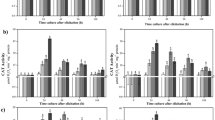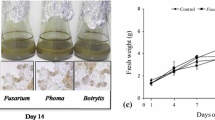Abstract
Constitutive phenolics of chickpea cell suspension cultures are the isoflavones formononetin and biochanin A, the isoflavanones homoferreirin and cicerin and the pterocarpans medicarpin and maackiain. They accumulate as vacuolar malonylglucosides. The biosynthetic pathways to isoflavones, pterocarpans and malonylglucoside conjugates together with their enzymes are explained. Elicitation of cell cultures leads to pronounced increases in the activities of biosynthetic enzymes with differential effects on the enzymes involved in conjugate metabolism. Low elicitor doses favour pterocarpan conjugate formation whereas high doses lead to pterocarpan aglycone accumulation accompanied by vacuolar efflux of formononetin and pterocarpan malonylglucosides. Elicitor-induced changes in enzyme activities and vacuolar efflux of conjugates are prevented by application of 10-3M concentrations of cinnamic acid. Cinnamate is alternatively metabolized to a glucose ester, a S-glutathionyl conjugate and to cell wall bounds forms; these reactions are intensified by elicitation. Isoflavone and pterocarpan biosynthesis and conjugate metabolism as regulated by elicitation and cinnamate is depicted in a metabolic grid to explain the complex regulatory pattern of phenolic accumulation in chickpea cell cultures.
Similar content being viewed by others
Abbreviations
- AOPP:
-
L-α-aminooxy-β-phenylpropionic acid
- BGM:
-
biochanin A 7-0-glucoside-6″-0-malonate
- FGM:
-
formononetin 7-0-glucoside-6″-0-malonate
- HPLC:
-
high performance liquid chromatography
- MaGM:
-
maackianin 3-0-glucoside-6′-0-malonate
- MeGM:
-
medicarpin 3-0-glucoside-6′-0-malonate
References
Barz W & Hösel W (1978) Metabolism and degradation of phenolic compounds in plants. Rec. Adv. Phytochem. 12: 339–369
Barz W, Köster J, Weltring KM & Strack D (1985) Recent advances in the metabolism and degradation of phenolic compounds in plants and animals. Ann. Proc. Phytochem. Soc. Europe 25: 307–347
Barz W & Welle R (1992) Biosynthesis and metabolism of isoflavones and pterocarpan phytoalexins in chickpea, soybean and phytopathogenic fungi. In: Stafford HA & Ibrahim RK (Eds) Recent Advances in Phytochemistry, Vol. 26 (pp 139–164). Plenum Press, New York
Barz W, Bless W, Börger-Papendorf G, Gunia W, Mackenbrock U, Meier D, Otto Ch & Süper E (1990a) Phytoalexins as part of induced defence reactions in plants: their elicitation, function and metabolism. In: Ciba Foundation Symposium 154, Bioactive Compounds from Plants, (pp 140–156). Wiley, Chicester
Barz W, Beimen A, Dräger B, Jaques U, Otto Ch, Süper E & Upmeier B (1990b) Turnover and storage of secondary products in cell cultures. In: Charlwood BV & Rhodes MJC (Eds) Secondary Products from Plant Tissue Culture, Vol 30 (pp 79–102). Proc. Phytochem. Soc. Europe, Oxford Science Publications
Bless W (1992) Untersuchungen zur Biosynthese der Pterocarpan-Phytoalexine in der Kichererbse (Cicer arietinum L.). Nachweis und Charakterisierung einer Pterocarpansynthase und einer Chalkonreduktase. Ph.D. thesis, University of Münster
Bolwell GP, Cramer CL, Lamb CJ, Schuch W & Dixon RA (1986) l-phenylalanine ammonia-lyase from Phaseolus vulgaris: modulation of the levels of active enzyme by trans-cinnamic acid. Planta 169: 97–197
Bolwell GP, Mavanad M, Millar DJ, Edwards KJ, Schuch W & Dixon RA (1988) Inhibition of mRNA levels and activities by transcinnamic acid in elicitor-induced bean cells. Phytochemistry 27: 2109–2117
Clemens S, Hinderer W, Wittkampf U & Barz W (1993) Characterization of cytochrome P450-dependent isoflavone hydroxylases from chickpea. Phytochemistry 32: 653–657
Cosio EG, Weissenböck G & McClure JW (1985) Acifluorfen-induced isoflavonoids and enzymes of their biosynthesis in mature soybean leaves. Whole leaf and mesophyll responses. Plant Physiol. 78: 14–19
Daniel S & Barz W (1990) Elicitor-induced metabolic changes in cell cultures of chickpea (Cicer arietinum L.) cultivars resistant and susceptible to Ascochyta rabiei, II. Planta 182: 279–286
Daniel S, Tiemann K, Wittkampf U, Bless W, Hinderer W & Barz W (1990) Elicitor-induced metabolic changes in cell cultures of chickpea (Cicer arietinum L.) cultivars resistant and susceptible to Ascochyta rabiei, I. Planta 182: 270–278
Dixon RA & Lamb CJ (1990a) Molecular communication in interactions between plants and microbial pathogens. Ann. Rev. Plant Physiol. Plant Mol. Biol. 41: 339–367
Dixon RA & Lamb CJ (1990b) Regulation of secondary metabolism at the biochemical and genetic levels. Proc. Phytochem. Soc. Europe. 30: 61–79
Dixon RA, Browne T & Ward M (1980) Modulation of l-phenylalanine ammonia lyase by pathway intermediates in cell suspension cultures of dwarf French bean (Phaseolus vulgaris L.). Planta 150: 279–285
Dixon RA, Choudlary AD & Dalkin K (1992) Molecular biology of stress-induced phenylpropanoid and isoflavonoid biosynthesis in alfalfa. In: Stafford HA, Ibrahim RK (Eds). Recent Advances in Phytochemistry, Vol 26 (pp 91–138) Plenum Press, New York
Edwards R & Owen WJ (1988) Regulation of glutathione S-transferases of Zea mays in plants and cell cultures. Planta 175: 99–106
Edwards R & Dixon RA (1991) Glutathione s-cinnamoyl transferases in plants. Phytochemistry 30: 79–84
Edwards R, Mayandad M & Dixon RA (1990) Metabolic fate of cinnamic acid in elicitor-treated cell suspension cultures of Phaseolus vulgaris. Phytochemistry 29: 1867–1873
Graham TL, Kim JE & Graham MY (1990) Role of constitutive isoflavone conjugates in the accumulation of glyceollin in soybean infected with Phytophthora megasperma. Molec. Plant-Microbe Interact. 3: 157–166
Gunia W, Hinderer W, Wittkampf U & Barz W (1991) Elicitor-induction of cytochrome P450 monooxygenases in cell suspension cultures of chickpea (Cicer arietinum L.) and their involvement in pterocarpan phytoalexin biosynthesis. Z. Naturforsch. 46c: 58–66
Hahlbrock K & Scheel D (1989) Physiology and molecular biology of phenylpropanoid metabolism. Ann. Rev. Plant Physiol. 40: 347–369
Höhl B, Pfautsch M & Barz W (1990) Histology of disease development in resistant and susceptible cultivars of chickpea (Cicer arietinum L.) inoculated with spores of Ascochyta rabiei. J. Phytopathol. 129: 31–45
Keßmann H & Barz W (1987) Accumulation of isoflavones and pterocarpan phytoalexins in cell suspension cultures of different cultivars of chickpea (Cicer arietinum L.). Plant Cell Rep. 6: 55–59
Lamb CJ, Lawton MA, Dron M & Dixon RA (1989) Signal and transduction mechanisms for activation of plant defences against microbial attack. Cell 56 215–224
Mackenbrock U & Barz W (1991) Elicitor-induced formation of pterocarpan phytoalexins in chickpea (Cicer arietinum L.) cell suspension cultures from constitutive isoflavone conjugates upon inhibition of phenylalanine ammonia lyase. Z. Naturforsch. 46c: 43–50
Mackenbrock U, Vogelsang R & Barz W (1992) Isoflavone and pterocarpan malonylglucosides and β-1,3-glucan- and chitin-hydrolases are vacuolar constituents in chickpea (Cicer arietinum L.). Z. Naturforsch 47c: 815–822
Mackenbrock U, Gunia W & Barz W (1993) Accumulation and metabolism of medicarpin and maackiain malonylglucosides in elicited chickpea (Cicer arietinum L.) cell suspension cultures. J. Plant Physiol. 142: 385–391
Shields SE, Wingate VPM & Lamb CJ (1982) Dual control of phenylalanine ammonialyase production and removal by its product cinnamic acid. Eur. J. Biochem. 123: 389–395
Tiemann K, Filmer B, Inzé D, van Montagu M & Barz W (1993) Phytoalexin biosynthesis in chickpea (Cicer arietinum L.) cDNA cloning and regulation of NADPH: isoflavone oxidoreductase (IFR). In: Fritig B & Legrand M (Eds) Mechanisms of Plant Defense Responses (pp 320–323) Kluwer Academic Publishers
Vogelsang R & Barz W (1993) Purification, characterization and differential hormonal regulation of a β-1,3-glucanase and two chitinases from chickpea (Cicer arietinum L.). Planta 189: 60–69
Vogelsang R (1993) Biochemische und molekularbiologische Untersuchungen über Abwehrreaktionen der Kichererbse (Cicer arietinum L.) nach Infektion mit dem Schadpilz Ascochyta rabiei. Ph. D. thesis, University of Münster
Weidemann C, Tenhaken R, Höhl U & Barz W (1991) Medicarpin and maackiain 3–0-glucoside-6′-0-malonate conjugates are constitutive compounds in chickpea (Cicer arietinum L.) cell cultures. Plant Cell Rep. 10: 371–374
Wink M (1993) The plant vacuole: a multifunctional compartment. J. Exp. Bot. Supplement. 44: 231–246
Author information
Authors and Affiliations
Rights and permissions
About this article
Cite this article
Barz, W., Mackenbrock, U. Constitutive and elicitation induced metabolism of isoflavones and pterocarpans in chickpea (Cicer arietinum) cell suspension cultures. Plant Cell Tiss Organ Cult 38, 199–211 (1994). https://doi.org/10.1007/BF00033878
Issue Date:
DOI: https://doi.org/10.1007/BF00033878




